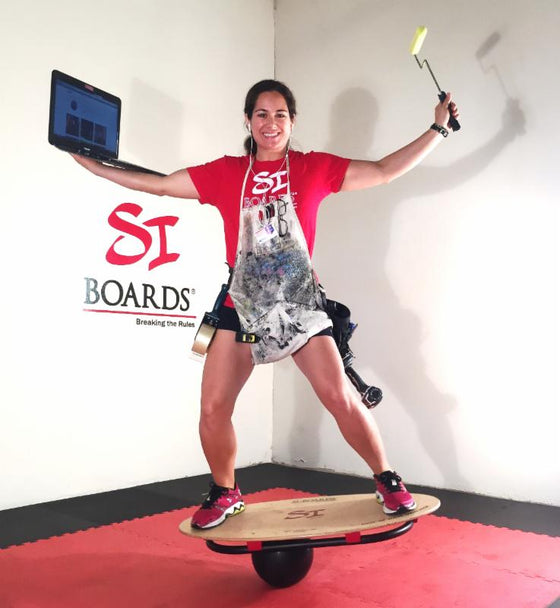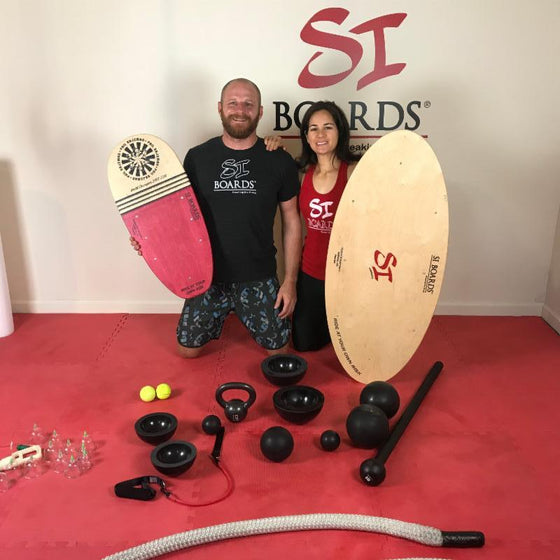Size Chart
Balance Boards







Medicine Balls


Half Balls


Rope Balls


I’ve used this Herringbone pattern taping technique on several types of injuries including an x-ray confirmed midfoot sprain, a swimmer with excessive foot motion and a runner putting in high mileage.
It is especially effective for complex bony structures that support the body in full weight bearing. The foot is a great example as it is made from 7 tarsal bones, 5 metacarpal bones and 14 phalanges- that’s 26 bones connected and stabilized as you walk, run and jump.
____________________________________________________________________
A Lisfranc injury is often under diagnosed. This type of injury involves the midfoot structures and can include bone fracture or ligament sprains. The 5 metatarsal, or long foot bones, connect with the medial cuneiform, intermediate cuneiform, lateral cuneiform and the cuboid bones. This area makes up the midfoot.
Your foot is flexible and changes with the surface it stands on. When you bear weight your bones splay and spread from one another but also must stay supportive to prevent total collapse.
To confirm this injury, x-rays in non-weight bearing and in weight bearing are needed. Non-weight bearing may show a normal joint. However, once in weight bearing the x-ray will show the joint gaping and opening up indicating a sprained ligament or fracture.
Simple walking can be painful once these building blocks of your foot are damage. Now imagine trying to dynamically move on a foot that crumbles. A midfoot sprain may present as a sore arch, plantarfascitis, general bruising or unknown pain. When foot rolling, icing or arch supports don’t seem to help then it’s time for an x-ray.
A fracture is usually treated with a cast or surgical fixation depending on the severity. But for those who have a ligament sprain and are in a walking boot or are allowed to play with restriction- this is a great tape technique.

____________________________________________________________________

Gently pull tape upward and toward midline of foot. Gently pull the skin downward to shorten the area under the tape
I use Leukotape because it will stick to the athletes for several days. I know the joint can be supported at all times, even when sleeping. This helps the healing process because it prevents the joint from excessive motion. The tape pulls the metatarsals upward towards the metacarpals and inward towards the mid-line of the foot.
Step 1: Cleanse the skin and prep with skin adhesive if needed. If the athlete has sensitive skin, apply cover roll as a base tape.
Step 2: Keep the foot in non-weight bearing and place in slight dorsiflexion. Don’t over correct the foot and excessively pull the foot towards the head because normal walking mechanics may be compromised.
Step 3: Use small strips about 3-5 inches, depending on the foot size. Tape from distal to poximal- from toes towards the ankle. Tack the first strip on the 1st metatarsal near the medial arch. Angle across the top of the foot and diagonally upwards toward the outside of the foot and ankle.
Step 4: Before tacking down the tape end, pull the skin down gently at the ending point towards the starting point. You are shortening the skin area below the tape.

Step 5: Do not pull the tape with great force. Give the tape a little bit of pull before tacking down the end.
Step 5: Repeat this technique from the 5th metatarsal, across the top of the foot and ending on the inside 1st metatarsal arch area. The criss-cross pattern should be placed over the site of the injury.
Step 6: Continue this pattern of pulling the outsides up, across, and towards the mid-line of the foot. The tape will have a criss-cross pattern known as a herringbone. I usually do 3-5 strips on each side depending on the foot size.
Step 7: As the sprain heals and the athlete goes back into competition, I will tape the foot with a little bit of weight bearing pressure. I have the athlete sit on the taping table, bend their knee and put their foot down on the taping table.
Always have the athlete walk after the tape application. Pain should be reduced and the foot should feel more secure. If pain is increased then the tape is too tight or taped in the opposite direction as advised.

Remember this is a supportive tape technique to prevent excessive joint motion. A little bit of joint re-positioning from a gentle pull of the tape is effective instead of cranking down on the area.
Click below to see the full twitter feed when a question was posed on treatment options.
@Monett_ATC @DrDavidGeier slight pull to avoid overcorrection. Should feel stable when walking and reduce pain. pic.twitter.com/qiBDmucjSz
— Si Boards, Inc (@siboards) September 19, 2013
Comments will be approved before showing up.


Big thank you to our social media fans for being awesome. I truly appreciate the respectful and caring nature of all our fans. When we need you- you are always there to lend advice and to welcome new Si Boarders. That makes us motivated to wake up every day with a drive to be better and help you fully use your Si Boards training tools. Thank you for being a part of the dream!












